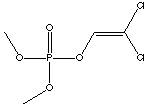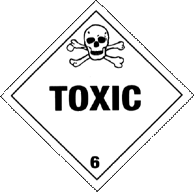Dichlorvos
- Dichlorophos
- 2,2-Dichlorovinyl dimethyl phosphate
- DDVP
- Dichlorovos

Dichlorvos | |
| |
| Formula | C4H7Cl2O4P |
| Structure |  |
| Description | An aromatic colorless to amber liquid absorbed in a dry carrier. |
| Uses | Chlorinated organic phosphate insecticide with appreciable vapor pressure. Incorporated into plastic strips it slowly releases vapor. Has been approved for use in disinfection of aircraft. |
| Registry Numbers and Inventories. | |
| CAS | 62-73-7 |
| EC (EINECS/ELINCS) | 200-547-7 |
| EC Index Number | 015-019-00-X |
| EC Class | Very toxic; Toxic; Sensitising; Dangerous for the Environment |
| RTECS | TC0350000 |
| RTECS class | Agricultural Chemical and Pesticide; Tumorigen; Drug; Mutagen; Reproductive Effector |
| UN (DOT) | 2783 |
| Merck | 12,3129 |
| Beilstein/Gmelin | 1709141 |
| Beilstein Reference | 4-01-00-02063 |
| EPA OPP | 600020 |
| Swiss Giftliste 1 | G-1472 |
| Canada DSL/NDSL | DSL |
| US TSCA | Listed |
| Austrailia AICS | Listed |
| New Zealand | Listed |
| Japan ENCS (MITI) | Listed |
| Korea ECL | Listed |
| Properties. | |
| Formula | C4H7Cl2O4P |
| Formula mass | 220.98 |
| Melting point, °C | 26 |
| Boiling point, °C | 177 |
| Vapor pressure, mmHg | 1.5 (25 C) |
| Density | 1.4205 g/cm3 (20 C) |
| Solubility in water | 5 g/L |
| Refractive index | 1.4545 (20 C) |
| Partition coefficient, pKow | 1.43 |
| Heat of vaporization | 39.6 kJ/mol |
| Hazards and Protection. | |
| Storage | Tightly closed containers. Keep away from heat and water, and keep area well ventilated. |
| Handling | All chemicals should be considered hazardous. Avoid direct physical contact. Use appropriate, approved safety equipment. Untrained individuals should not handle this chemical or its container. Handling should occur in a chemical fume hood. |
| Protection | Wear appropriate protective gloves, clothing and goggles. |
| Respirators | Wear positive pressure self-contained breathing apparatus (SCBA). |
| Small spills/leaks | Keep sparks, flames, and other sources of ignition away. Keep material out of water sources and sewers. Build dikes to contain flow as necessary. Attempt to stop leak if without undue personnel hazard. Use water spray to knock-down vapors. Land spill: Dig a pit, pond, lagoon, holding area to contain liquid or solid material. Cover solids with a plastic sheet to prevent dissolving in rain or fire fighting water. Water spill: Use natural deep water pockets, excavated lagoons, or sand bag barriers to trap material at bottom. If dissolved, in region of 10 ppm or greater concentration, apply activated carbon at ten times the spilled amount. Use mechanical dredges or lifts to remove immobilized masses of pollutants and precipitates. |
| Stability | Stable to heat. |
| Incompatibilities | Incompatible with strong acids and bases It is |
| Decomposition | Readily decomposition in strong acid or alkali decomposition products may include toxic gases and vapors of hydrogen chloride gas, phosphoric acid mist and carbon monoxide. |
| Fire. | ||||
| Flash Point,°C | 80 | |||
| Fire fighting | Use water in flooding quantities as fog. Use foam, dry chemical, or carbon dioxide. Cool all affected containers with flooding quantities of water. Apply water from as far a distance as possible. Keep run-off water out of sewers and water sources. | |||
| Fire potential | Moderately flammable. | |||
| Hazards | Toxic chloride fumes and phosgene formed if heated to decomposition or on contact with acid or acid fumes. Corrosive to iron and mild steel, acids or acid fumes. Hydrolyzes in water. | |||
| Combustion products | Toxic gases and vapors (such as hydrogen chloride gas, phosphoric acid mist, and carbon monoxide) may be released in a fire involving dichlorvos. | |||
| Health. | |
| Exposure limit(s) | TLV (as TWA): 0.1 ppm; 0.90 mg/m3 A4, (Skin) (ACGIH 1997). OSHA PEL: TWA 1 mg/m3 skin NIOSH REL: TWA 1 mg/m3 skin NIOSH IDLH: 100 mg/m3 |
| Carcinogin | I-2B, CP65 |
| Poison_Class | 2 |
| Exposure effects | Vital sign changes can include slow or rapid heart rate, abnormally low blood pressure or elevated blood pressure, rapid breathing, respiratory paralysis or fever. Headache, dizziness, muscle spasms, profound weakness, paralysis, confusion, slurred speech and loss of reflexes are common symptoms of dichlorvos overexposure. Altered level of consciousness, seizures and coma may occur. Seizures may be more common in children. |
| Ingestion | Vomiting, diarrhea, fecal incontinence, pancreatitis and abdominal pain may occur after exposure to dichlorvos. |
| Inhalation | Dyspnea, rales, bronchorrhea, tachypnea, cheyne-stokes respiration, or apnea may occur, with pulmonary edema or paralysis of respiratory muscles and death in severe cases. |
| Skin | Sweating is a consistent but not universal sign. |
| Eyes | Constriction of the pupil, tearing, blurred vision and salivation are common. Prolonged dialation of the pupils may occur in severe poisonings. |
First aid |
|
| Ingestion | Seek medical assistance. |
| Inhalation | Move victim to fresh air. Apply artificial respiration if victim is not breathing. Do not use mouth-to-mouth method if victim ingested or inhaled the substance; induce artificial respiration with the aid of a pocket mask equipped with a one-way valve or other proper respiratory medical device. Administer oxygen if breathing is difficult. |
| Skin | Remove and isolate contaminated clothing and shoes. Immediately flush with running water for at least 20 minutes. For minor skin contact, avoid spreading material on unaffected skin. |
| Eyes | Immediately flush with running water for at least 20 minutes. |
| Transport. | ||
| UN number | 2783 |  |
| Response guide | 152 | |
| Hazard class | 6.1 | |
| Packing Group | I; II; III | |
| USCG CHRIS Code | DCV | |
| Std. Transport # | 4921537 | |